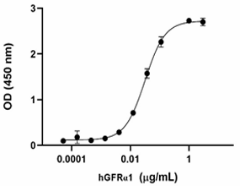- Regulatory Status
- RUO
- Other Names
- HGDNF, HFB1-GDNF, ATF1, ATF2, ATF, HSCR3

-

When recombinant mouse GDNF is immobilized at 0.5 µg/mL, recombinant human GFRα1 binds in a dose-dependent manner. HRP Protein A (Cat. No. 689202) was used to detect the binding. The ED50 for this effect is 20 – 150 ng/mL. -

Stability Testing for Recombinant Mouse GDNF. Recombinant Mouse GDNF was aliquoted in 0.1% TFA with at 0.2 mg/mL and one aliquot was kept at 4°C (Control), and another was frozen and thawed four times (4x Freeze/Thaw). The samples were tested in a binding assay with immobilized recombinant mouse GDNF at 0.5 µg/mL and different concentration of recombinant human GFRα1 that binds in a dose-dependent manner. The ED50 for this effect is 20 – 150 ng/mL.
| Cat # | Size | Price | Quantity Check Availability | ||
|---|---|---|---|---|---|
| 799904 | 25 µg | $310.00 | |||
| 799906 | 100 µg | $1095.00 | |||
Select size of product is eligible for a 40% discount! Promotion valid until December 31, 2024. Exclusions apply. To view full promotion terms and conditions or to contact your local BioLegend representative to receive a quote, visit our webpage.
Glial cell line-derived neurotrophic factor (GDNF) is a member of the TGF-β superfamily and was first identified as a growth factor supporting the survival of embryonic midbrain neurons. GDNF has been shown to promote the development, differentiation, and survival of dopaminergic neurons by signaling through GDNF family receptor α-1 (GFRα1) and the coreceptor RET, a tyrosine kinase receptor. Dysregulated expression of GDNF has been reported to be associated with several mental diseases, which include depression and schizophrenia. GDNF is considered as a promising therapeutic agent for the treatment of Parkinson's disease because it can protect dopaminergic neurons from neurotoxins and promotes neuron regeneration after injury. In addition to the functions in the nervous system, GDNF is also required for the differentiation of spermatogonia and kidney development. Upregulated expression of GDNF was observed in various cancer cell lines and correlates with malignant cancer progression, suggesting a role of GDNF in carcinogenesis.
Product Details
- Source
- Recombinant mouse GDNF, amino acid Ser78-lle211 (Accession No. P48540) was expressed in E. coli
- Molecular Mass
- The 134 amino acid recombinant protein has a predicted molecular mass of approximately 15.0 kD. The DTT-reduced and non-reduced proteins migrate at approximately 17 kD and 28 kD by SDS-PAGE, respectively. The predicted N-terminal amino acid is Ser.
- Purity
- > 95%, as determined by Coomassie stained SDS-PAGE.
- Formulation
- 0.22 µm filtered protein solution is in 0.1% TFA
- Endotoxin Level
- Less than 0.1 EU per µg cytokine as determined by the LAL method.
- Concentration
- 25 µg size is bottled at 200 µg/mL. 100 µg size and larger sizes are lot-specific and bottled at the concentration indicated on the vial. To obtain lot-specific concentration and expiration, please enter the lot number in our Certificate of Analysis online tool.
- Storage & Handling
- Unopened vial can be stored between 2°C and 8°C for up to 2 weeks, at -20°C for up to six months, or at -70°C or colder until the expiration date. For maximum results, quick spin vial prior to opening. The protein can be aliquoted and stored at -20°C or colder. Stock solutions can also be prepared at 50 - 100 µg/mL in appropriate sterile buffer, carrier protein such as 0.2 - 1% BSA or HSA can be added when preparing the stock solution. Aliquots can be stored between 2°C and 8°C for up to one week and stored at -20°C or colder for up to 3 months. Avoid repeated freeze/thaw cycles.
- Activity
- Immobilized recombinant mouse GDNF binds recombinant human GFRα1 (Cat. No. 788102) in a dose-dependent manner. The ED50 for this effect is 20 – 150 ng/mL.
- Application
-
Bioassay
- Application Notes
-
BioLegend carrier-free recombinant proteins provided in liquid format are shipped on blue-ice. Our comparison testing data indicates that when handled and stored as recommended, the liquid format has equal or better stability and shelf-life compared to commercially available lyophilized proteins after reconstitution. Our liquid proteins are validated in-house to maintain activity after shipping on blue ice and are backed by our 100% satisfaction guarantee. If you have any concerns, contact us at tech@biolegend.com.
Antigen Details
- Structure
- Dimer
- Distribution
-
GDNF is a secreted protein that is widely expressed in the developing and adult central nervous systems; it participates in the recovery process after brain surgery
- Function
- Promote the development, differentiation, and survival of dopaminergic neurons
- Interaction
- Neuronal cells expressing GDNF family receptors
- Ligand/Receptor
- GDNF family receptor α-1 (GFRα1); possesses lower affinity for GFRα2, GFRα3, and GFRα4
- Bioactivity
- Measured by its ability to bind recombinant human GFRα1
- Cell Type
- Embryonic Stem Cells, Neural Stem Cells
- Biology Area
- Cell Biology, Neuroscience, Stem Cells, Synaptic Biology
- Molecular Family
- Growth Factors
- Antigen References
-
- Allen SJ, et al. 2013. Pharmacol Ther. 138:155-75.
- Hendrich J, et al. 2012. Neuroscience. 219:204-13.
- Hidalgo-Figueroa M, et al. 2012. J Neurosci. 32:864-72
- Pascual A, et al. 2011. J Mol Endocrinol. 3:R83-92.
- Carnicella S, et al. 2009. Pharmacol Ther. 122:9-18.
- Sariola H, et al. 2003. J Cell Sci. 116:3855-62.
- Jmaeff S, et al. 2020. Mol Pharmacol. 98:1-12.
- Gene ID
- 14573 View all products for this Gene ID
- UniProt
- View information about GDNF on UniProt.org
